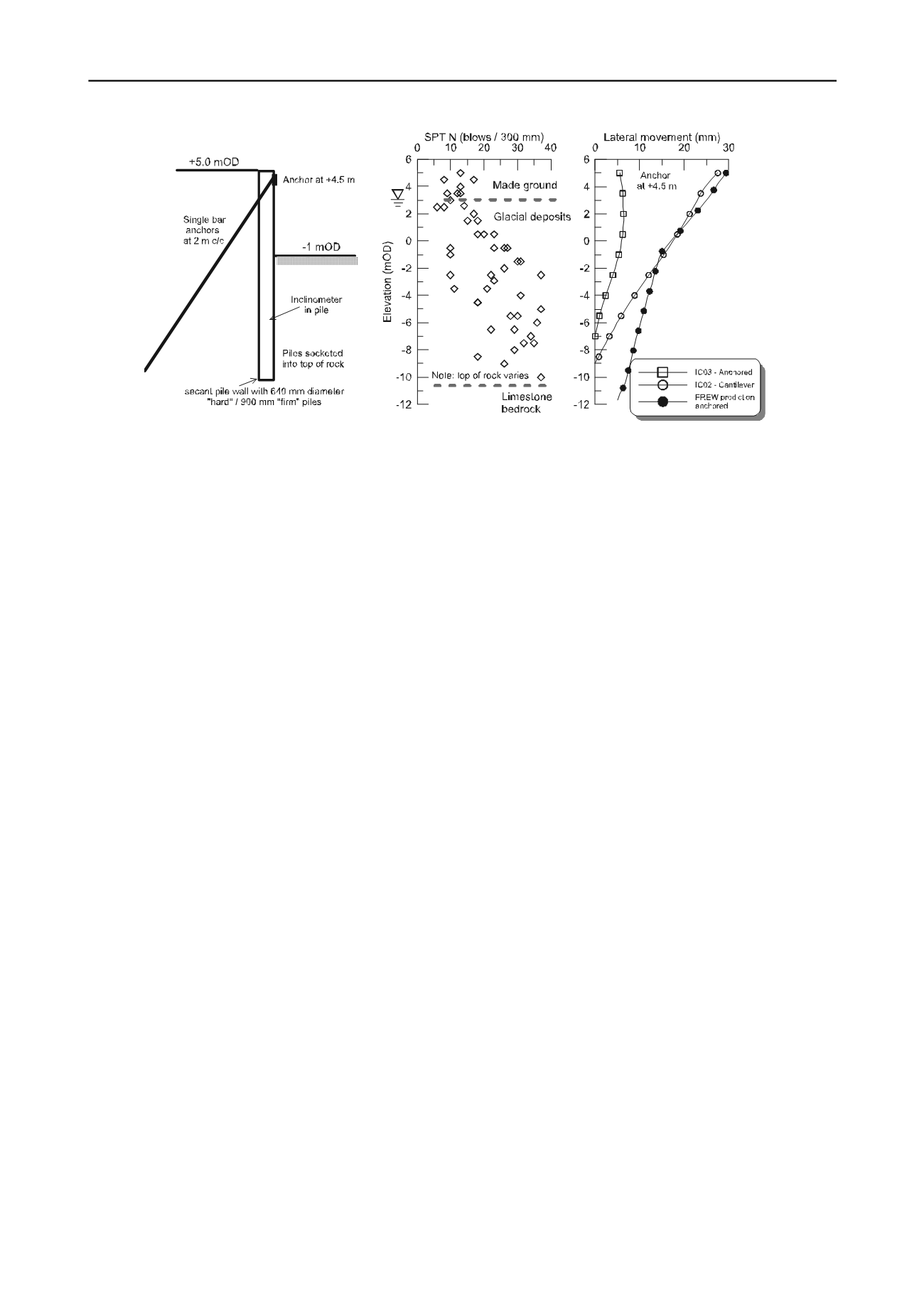
2042
Proceedings of the 18
th
International Conference on Soil Mechanics and Geotechnical Engineering, Paris 2013
There is scope for greater use of cantilever walls and walls and
systems with lower stiffness.
Figure 5. Midleton
10 ACKNOWLEDGEMENTS
8 DISCUSSION
The reasons for the very stiff behaviour of the retaining walls in
Irish glacial deposits are complex but are due to a combination
of the following factors:
Excavation induced depressed pore pressures (or even
suctions) in the material. These result in increased effective
stress and hence stability (Long et al., 2012a).
Some of the data used in this paper was kindly provided by Mr.
Tony O’Dowd of PJ Edwards & Co., Mr. Pat Fox of Murphy
International Ltd., Mr. Patrick Casey of Arup Consulting
Engineers and Mr. Eddie Meade of NVM Ltd. and their co-
operation is gratefully acknowledged.
The low permeability of the clay fraction of the material
(10
-10
m/s or less) meaning that the dissipation of the
depressed pore pressures takes a long time.
11 REFERENCES
BSI, 1994.
Code of practice for earth retaining structures
The material has extremely high strength and stiffness.
A possible approach for the design of temporary retaining
structures in the clay fraction of the material may be in the use
of undrained parameters in conjunction with the observational
approach. This approach should only be considered where the
predicted deflections using an effective stress approach would
be within defect limits to prevent the possibility of damage,
economic loss or unsafe situations. The risk associated with the
decision should be clearly assessed in terms of understanding of
the site geology, type and condition of structures to the rear of
the pile wall and the quality of monitoring procedures and
contingency measures put in place.
It seems there is scope for the greater use of cantilever
walls, less stiff walls (e.g. smaller diameter piles) and also
greater retained heights at least for temporary works purposes. It
must also be emphasised that an effective stress design
approach is always needed for the ultimate limit state analysis in
permanent works as the suctions will eventually dissipate.
Burland, J.B., Broms, B.B. and De Mello, V., 1977. Behaviour of
foundations and structures,
Proceedings. IX
t.h
International
Conference on Soil Mechanics and Foundation Engineering,
Tokyo, pp. 495 - 546.
Clough, G.W. and O’Rourke, T.D., 1990. Construction induced
movements of in situ walls,
Proceedings ASCE Conf. on
Design and Performance of Earth Retaining Structures,
ASCE Pub. No. 25, Cornell, pp. 439 - 470.
Clough, G.W., Smith, E.M. and Sweeney, B.P., 1989. Movement
control of excavation support systems by iterative design,
Proceedings ASCE Foundation Eng: Current Principles and
Practices
. ASCE, pp. 869 - 884.
Edwards, K.J. and Warren, W.P., 1985. The Quaternary studies in
Ireland. In: K.J. Edwards and W.P. Warren (Editors),
The
Quaternary History of Ireland
. Academic Press, London, pp.
1 - 16.
Gaba, A.R., Simpson, B., Powrie, W. and Beadman, D.R., 2003.
Embedded retaining walls - Guidance for economic design,
CIRIA Report
No. C580.
Long, M., 2001. A database for retaining wall and ground movements
due to deep excavations. J
ournal of Geotechnical and
Geoenvironmental Engineering,
ASCE, 127(3): 203 - 224.
Long, M., Brangan, C., Menkiti, C., Looby, M. and Casey, P., 2012a.
Retaining walls in Dublin Boulder Clay, Ireland.
Institution
of Civil Engineers Journal of Geotechnical Engineering,
165(GE4, August): 247 - 266.
9 CONCLUSIONS
Case history data confirms that retaining wall behaviour in Irish
glacial deposits is extremely stiff.
Long, M., Daynes, P.J., Donohhue, S. and Looby, M., 2012b. Retaining
wall behaviour in Dublin's fluvio-glacial gravel, Ireland.
Institution of Civil Engineers Journal of Geotechnical
Engineering,
165(GE5, October ): 289 - 307.
The reasons for this stiff behaviour lie in the low permeability
and high strength and stiffness of the material and the resulting
very slow dissipation of depressed excavation induced pore
pressures.
Long, M., Menkiti, C., Skipper, J., Brangan, C. and Looby, M., 2012c.
Retaining wall behaviour in Dublin's estuarine deposits,
Ireland.
Institution of Civil Engineers Journal of
Geotechnical Engineering
, 165(GE6, December): 351 - 365.
It appears that the current approach, for serviceability limit state
calculations, which usually involves beam – spring type
computer programs is clearly conservative.
Long, M., Murphy, M., Roberts, T., Clancy, N. and Murphy, P., 2013.
Deep excavations in water bearing gravels in Cork.
Quarterly Journal of Engineering Geology
(QJEGH) Paper
submitted November 2012.
Peck, R.B., Hanson, W.E. and Thorburn, T.H., 1974. F
oundation
Engineering
2nd Edt. John Wiley and Sons, New York.
For temporary works, the use of undrained parameters in
conjunction with the observational approach may be considered
for reducing predicted deflections to simplify the construction
sequence and reduce costs.
Stroud, M.A., 1988. The standard penetration test: its application and
interpretation,
Proceedings ICE Conference on Penetration
Testing in the UK
. Thomas Telford, London, University of
Birmingham, pp. 29 - 51.


